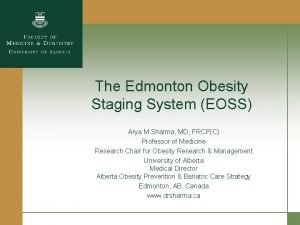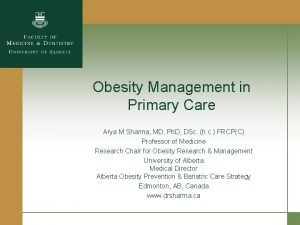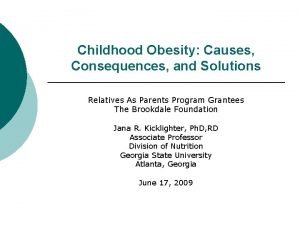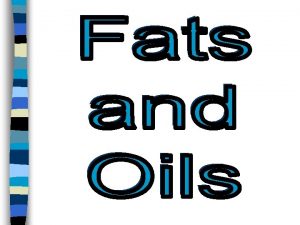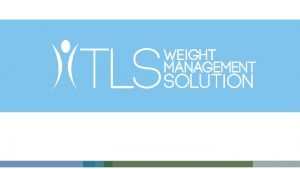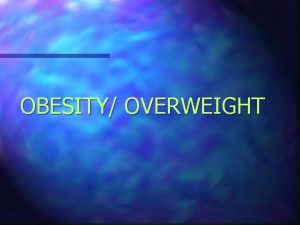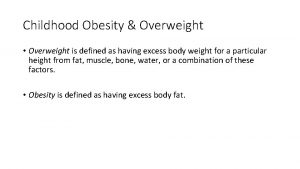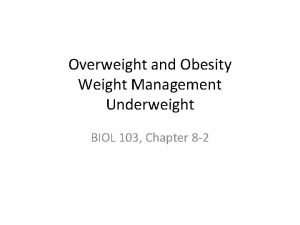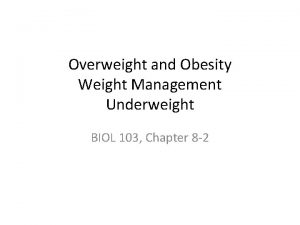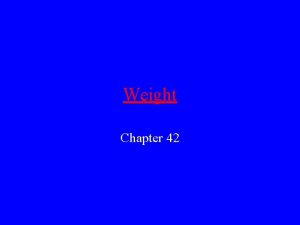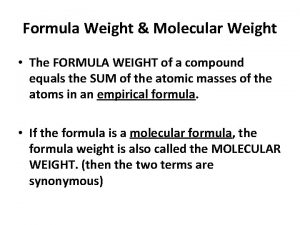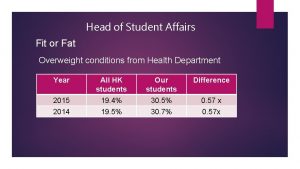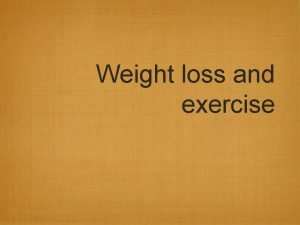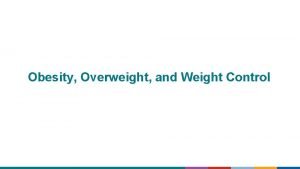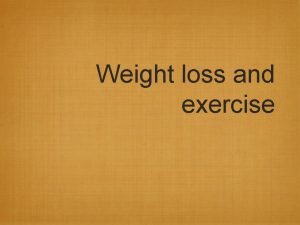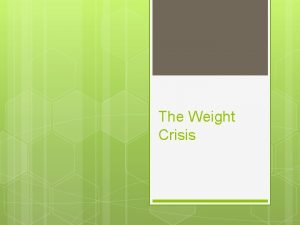Weight Management Overweight Fat Cell Development Fat cell



































- Slides: 35

Weight Management Overweight

Fat Cell Development �Fat cell numbers and size During the growing years (Later childhood and early puberty) fat cells respond to overfeeding by producing additional fat cells rapidly the number of fat cells eventually becomes fixed. Overfeeding from this point on causes the body to enlarge existing fat cells. After maximum size is reached, more cells Develop to store more fat.

Fat Cell Metabolism Lipoprotein lipase promotes fat storage. In addition , there is gender differences �Men are at increased risk for developing central obesity and women are at increased risk for lower body fat. �Enzymes that break down fats affect men and women differently.

Causes of Overweight and Obesity �Genetics Studies have demonstrated role of genetics in susceptibility to obesity , as well as influences on energy storage and energy expenditure.

Enzyme and hormone factors A- Lipoprotein lipase (LPL) �Fat cells of obese people contain higher levels of the enzymes lipoprotein lipase (LPL), which determine the rate at which adipose cells store fat

Lipoprotein lipase (LPL) An enzyme located on the surfaces of fat cells that enables the cell to convert blood triglycerides into fatty acids and glycerol to be pulled into the cell for storage as body fat. � The larger the fat cell (and the greater the number of fat cells), the more LPL and the more easily the body can pull triglycerides into fat cells for storage. � Even modest excess in energy intake has more dramatic effect on obese people than lean people.

B-Leptin (ob protein) �Leptin is a protein that acts as a hormone to increase energy expenditure and decrease appetite. �Produced by fat cells under the direction of the ob gene. �Gain in body fat stimulates production of leptin , resulting in appetite suppression and increased energy expenditure (leptos =thin) �May be deficient in obese individuals or there is a resistance to its effects.

C-Ghrelin �Ghrelin is a protein that acts as a hormone to decrease energy expenditure and increase appetite. �Ghrelin is synthesized and secreted by stomach cells.

Medical disorders and treatment �Medical disorders and treatment may increase body weight such as : 1. Down syndrome , hypothyroidism. 2. Pharmacological agents (hormonal contraceptives –corticosteroids) 3. Smoking cessation. 4. Night eating syndrome. 5. Insulin 6. Polycystic ovary syndrome.

Enviromental factors 1. Overeating �Present and past eating influences current body weight. �Increased availability of convenient food, large portions, and energy –dense foods.

2 - Physical Inactivity � Modern technology replaces physical activites. � Too little energy expenditure may be as much a cause of overweight as excessive energy intake

Assessment of obesity �Although obesity can easily be identified at first sight , a precise assessment requires measurements and reference standards.

1 -Body weight �If a person is more than 10% standard weight we call him overweight more than 20% is obese. %body weight excess of normal Degree of obesity 25% Mild 50% Moderate 75% Severe 100% Very severe

2 -BMI (body mass index) �Body mass index is used to define obesity by measuring Weight /height ratio. It determines whether person at health risk from excess weight. It is obtained by dividing weight in kilograms by height in meters squared.

Grading of obesity can be done based on BMI �Grade III : >40 �Grade II : 30 -40 �Grade I : >25 -29. 9 �Not obese : <25

Disadvantages of BMI does not account for: 1 -Location of fat in the body. 2 - Muscular people with a low percentage of body fat may have a high BMI. 3 -It is also not a valid during pregnancy.

Are there health implications to how body fat is distributed? �Central obesity: excess fat on the abdomen and around the trunk is called “Apple –shaped” body Strong risk factor for type 2 diabetes , heart disease , hypertension, and other problems. �Peripheral obesity: excess fat on the thighs , hips , and buttocks is called “Pear –shaped” body.


3 - Waist circumference �Waist circumference measurement provides information about the distribution of fat in the abdomen. Disease risk rises when waist circumference exceeds: � 35 inches in women (90 cm) � 40 inches in men (102 cm) �Risk equal to a BMI of 25 to 34. 9

Health Risks of obesity Obese and overweight people have high risk for developing the following conditions which may be improved by losing weight: 1 - Type 2 diabetes 2 - High blood pressure 3 - CHD 4 - Cancer 5 - Sleep apnea 6 - Mortality

Weight –Loss Strategies �A life – long eating plan for good health is best for achieving permanent weight loss includes: a-Nutritionally adequate eating plan b-Reasonable expectations c- Regular physical activity d- Permanent lifestyle changes

A-Nutritionally adequate eating plan �Diet should be nutritionally adequate while avoiding excessive consumption. � 300 -500 Kcalories/day reduction for BMI between 27 -35. � 500 -1000 Kcalories/day reduction for BMI ≥ 35. �Eat no less than 1, 200 calories per day. �Diet should consist of 10 to 35 percent protein , 45 to 65 percent carbohydrate, and 20 -35 percent or less fat. �Smaller portions are recommended to feel satisfied , not stuffed.

�Eat foods of lower energy density that are high in fiber, high in water and low in fat. �Water is important to increase fullness and reduce hunger. �Complex carbohydrates offer abundant vitamins, minerals and fiber with little fat. �Watch empty Kcalories from sugar and alcohol.

B-Reasonable expectations �Lose no more than 1 to 2 pounds per week (half to one Kilogram per week)

C-Regular physical activity Activity for 60 minutes /day at moderate intensity contributes to 1. Influence Energy expenditure 2. Increased Metabolic rates 3. Decrease body fat and increase lean body mass 4. Appetite control 5. Psychological benefits : reduce stress and improves self-esteem

D-Permanent lifestyle changes �Change eating habits �Develop new and healthy eating plan and exercise program �Learn difference between hunger and appetite

Aggressive Treatment of obesity �Individuals with clinically severe obesity and major medical problems may benefit from Weight loss drug Bariatric surgery �But changing and improving eating and exercise habits offer the greatest benefit.

1 -Weight loss drugs �Used with BMI≥ 30 or ≥ 27 with risk factor. Disadvantages of these drugs �There are many side effects � Effectiveness reduced within short time � Causes nervousness

Sibutramine � Appetite suppressant; works on neurotransmitters in brain enhances satiety & elevates energy expenditure � Most effective when combined with a reduced –Kcalorie diet& increased physical activity. � Side effects : dry mouth , rapid heart rate , insomnia , headache , high blood pressure. Orlistat � Reduces 30% fat digestion &absorption by inhibiting fat digesting enzymes in the GI tract � Fat leaves digestive tract intact carrying fatsoluble vitamins & phytochemicals � Side effects: similar to those of artificial fat olestra such as diarrhea &digestive distress

2 - Surgery �Surgery is an option for those who have tried weight loss programs and failed , have a BMI ≥ 35 and are having health problems due to their weight.

Gastric surgeries �Gastric bypass: restricts stomach capacity & reroutes food form stomach to lower part of small intestine; creates chronic , lifelong state of malabsorption of nutrients �Gastric banding: reduction of stomach size by use of restrictive band –have short term and long term problems. Both require certain dietary instructions

Does the use of Diuretics and Laxatives useful in weight loss? � The use of Diuretics and Laxatives do not cause reduction of body fat but only water. �Excess water loss can result in fluid and electrolyte imbalance. �Laxatives can become habit –forming.

Underweight What is underweight? It is far less prevalent a problem than overweight and may be associated with a major eating disorder : anorexia nervosa. Underweight: Weight 10% or more below the desirable weight for height , or a BMI less than 18. 5. Possible causes of underweight: Poor nutrition , psychological or physical conditions, or genetics

Problems of underweight individuals �Possess minimal fat stores �Could be at a disadvantage when energy reserves are needed (during pregnancy). �Menstrual irregularity , infertility , osteoporosis. �More hazardous when accompanied by under nutrition.

Weight –Gain Strategies �Regular meals each day must become a priority. �Use large portions and expect to feel full. �Consume extra snacks between meals. �Juice and milk are easy ways to increase Kcalories. �Exercising to build muscles will support increases in muscle mass.
 Tolerable weight
Tolerable weight Examples of bulk gaining
Examples of bulk gaining Alabama wide load permit
Alabama wide load permit Overweight connotative meaning
Overweight connotative meaning Negative connotation for overweight
Negative connotation for overweight Overweight connotative meaning
Overweight connotative meaning Overweight
Overweight Overweight
Overweight Arya overweight
Arya overweight Arya overweight
Arya overweight Loadmatch chicago
Loadmatch chicago Pineapple baby madison overweight
Pineapple baby madison overweight Trans fat vs cis fat
Trans fat vs cis fat Examples of invisible fat
Examples of invisible fat Tls nutrition shake review
Tls nutrition shake review Chapter 13 healthy weight management answers
Chapter 13 healthy weight management answers Tls weight management
Tls weight management Springfield weight management
Springfield weight management Tier 2 weight management service specification
Tier 2 weight management service specification Long thin vs short fat process
Long thin vs short fat process Top management middle management first line management
Top management middle management first line management Management pyramid
Management pyramid Top management middle management first line management
Top management middle management first line management Community development was written by
Community development was written by Development that ended much development crossword
Development that ended much development crossword The development of an object that is rolled or folded
The development of an object that is rolled or folded Early studies led to the development of the cell theory
Early studies led to the development of the cell theory Spongebob cell analogy
Spongebob cell analogy Advantages and disadvantages of diaphragm cell process
Advantages and disadvantages of diaphragm cell process Site:slidetodoc.com
Site:slidetodoc.com Prokaryotic reproduction
Prokaryotic reproduction Plant cell outline
Plant cell outline Spontaneity electrochemistry
Spontaneity electrochemistry Dry cell vs wet cell
Dry cell vs wet cell Plant vs animal cell venn diagram
Plant vs animal cell venn diagram Cell wall function
Cell wall function








